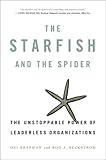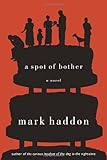Like HCI books, lately for some reason I’ve been reading more business books. Not totally sure why — I think maybe it’s because I can get through a whole book in an afternoon, compared to, say, Blood Meridian, which I’m struggling through as bedtime reading (it’s amazing, like most of McCarthy’s work — just challenging). Anyway, I picked this one up because I saw it on Diego’s blog — he’s had some recommendations lately that I’ve enjoyed.
The premise of this book is that there are a couple of very distinct models for organizations: centralized (the spider) and wholly decentralized (the starfish). The authors (Stanford GSBers, but worth reading in spite of that…) use this analogy: cut off the head of a spider and the spider dies. Cut off an arm of a starfish, and you often end up with two starfish. Starts by exploring the Spanish conquests of the Incas & Aztecs (spider organizations) and comparing them to the United States’ mostly ineffectual campaign against the Apaches (a starfish organization). The Apaches were harder to fight against because decisions weren’t made by any one person, but were made on what the US would have perceived as the edges — by medicine men who were empowered by their community. The strange thing (for the US, at any rate) was that whenever they killed any of these important people, more would spring up in their place. I thought it was interesting that the authors point to the US giving the Apaches cattle as something that ultimately led to the disintegration of their coherent society. (The implication here is that the sedentary nature of livestock & farming necessitated the creation of societal structures which were more centralized and less flexible — spider-thinking, where there was only starfish-thinking previously.)
As someone who works on and thinks about one of the most successful starfish organizations in the software industry, there was a lot in this short book for me to consider. Mozilla’s roots, of course, since the beginning have been more like a starfish than like a spider — but as we get more and more important to the world, there’s a strong pressure to add spider-like process in places. I think that’s natural and not at all bad — there are things that spiders can do more effectively than starfish — and, in truth, virtually every organization is somewhere on a spectrum between starfish & spider. The trick, I think, is in doing the right style in the right situations. This leads to some strange decisions. Like, for example, in a starfish-oriented software organization, it’s exceedingly difficult to really know how many actual people use your software (very analogous to Alcoholics Anonymous not having any real sense of exactly how many members are in their organization). Sometimes with starfish, it’s better to be approximately right, than either precisely wrong, or, worse, precisely right in ways that impede your ability to succeed on your own starfishy terms.
What we’re doing at Mozilla is in many ways unprecedented — a blending of starfish & spider thinking on a scale that affects hundreds of millions of people every day (either directly through the use of Firefox or indirectly). So I’m happy to have material like this that’s thought-provoking and useful to remind us that while things are newish, many others have done things that can serve as models.
I think this would be useful for anyone to read, whether you’ve thought much about the topic or not. I’ve said this many times to folks around here, but I really think that small, highly leveraged, highly decentralized organizations are the future — so in this respect Mozilla (and other starfish) can act as pathfinders.





slide.013-tm.jpg
Apr 5, 21:31 › bizim mekan: thank you very much admin. Oct 18, 6:51 › duygu sohbet: seviyeli online duygu sohbet odalar? Oct 6, 10:01 › ????????: 1968's "The Secret War of Harry Frigg" stars Paul Jun 13, 23:25 › PeterKed:Home
Jun 26, 21:11 › kev: I am sorry I missed this when it actually occurred Jun 19, 17:00 › Ken: I was doing a search on "shoulder problems" and came